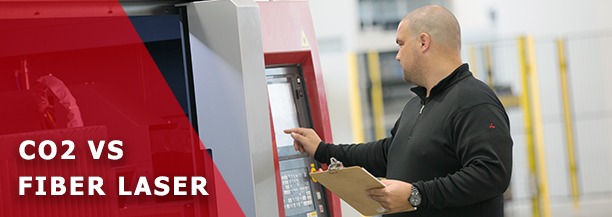When choosing between a fiber and CO2 laser there are several factors to consider. While one may carry more weight than the other depending on your application, they should all come into play when making such a significant investment in the future of a business. While we work closely with customers to ensure they choose the ideal system for their specific work, facility, and team, there are some fundamental differences between the technologies. Let’s explore a few.
Power Consumption
When comparing fiber and CO2 lasers, the easiest topic to discuss is power consumption. The fiber consumes much less electricity. The savings not only comes from the oscillator but also the chiller unit. The 4kW fiber and chiller, when on at maximum power, will consume approximately 18 kW. The equal-powered CO2 laser and chiller will consume approximately 70 kW.
Speed
A fiber laser can cut many of the same materials as a CO2, plus copper, brass, and aluminum much better because the beam is more readily absorbed and not reflected. For example, cutting .125-inch aluminum and thinner, using ABR as an assist gas can produce speeds 3x higher than CO2. The fiber also enables marking on the aluminum. For mild steel cutting with oxygen, the speeds are similar, but the pierce time is much less on fiber. Above .5 inch, the CO2 has finer edge quality. For stainless steel cutting with nitrogen, the speeds of the fiber are faster, but the edge quality of the CO2 is finer.
Safety
The CO2 laser is a Class IV system. This means the operator is protected from direct beam contact, but the system is not fully enclosed. Normal plastic enclosures and safety glasses can be used for eye protection. Often, access to the workpiece is quick and easy. The fiber laser has a wavelength that is much more dangerous and special precautions must be exercised. This is why fiber laser systems are fully enclosed and are a Class I. The plastic for viewing the processing area must be of the optical density that will not allow transmission of the fiber wavelength, causing a higher expense. Manufactures generally limit the number of windows the machine has, making it harder to see what is happening while cutting.
Edge Quality
A major difference is the edge quality. In all thicknesses, including stainless and aluminum, the CO2 cuts with finer edge quality. As the thickness increases, so does the difference. CO2 lasers can produce better edge quality on thick-plate stainless and aluminum workpieces that fiber lasers can’t. One factor of the rougher edge on the fiber is the higher assist gas consumption. The fiber will consume up to 30 percent more assist gas. The primary reason for this is the smaller spot size. The 1.07-μm wavelength of the fiber is better suited for cutting the reflective materials the thinner metal market, but with power increasing, the application area is growing.
Cost
Cost is also a big factor. Fiber laser operating costs are typically half of that of a CO2 system due to the lower electrical consumption and high electrical efficiency of fiber lasers. The energy savings come from both the oscillator and the chiller unit. The 4kW fiber laser and chiller, when running at maximum power, will consume approximately 18kW. A CO2 laser and chiller running at the same power will consume approximately 70kW. This results in significant cost savings.
Conclusion
The adoption of fiber lasers has been slow in many shops. CO2 lasers are a tried-and-true technology and manufacturers are hesitant to invest so much in something entirely new. If the application fits though, a fiber laser can be a great option.
Deciding which machine is right for your shop is a matter of reviewing your applications and materials used. While one shop might benefit from the speed of a fiber laser, another might need the cutting quality of a CO2.
MC Machinery recognizes the importance of each technology and continues to develop both fiber and CO2 technologies that work on a variety of applications. When the time comes for your shop to add a machine, MC Machinery will be able to find the right solution to get the most bang for your buck. Contact us to get started.

